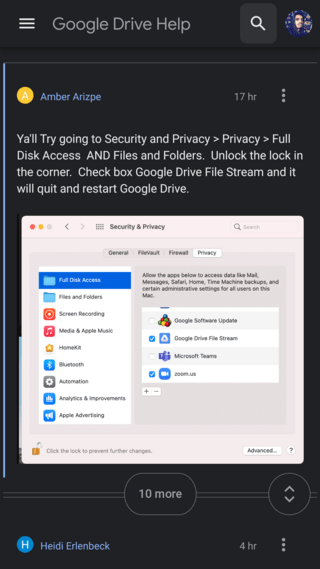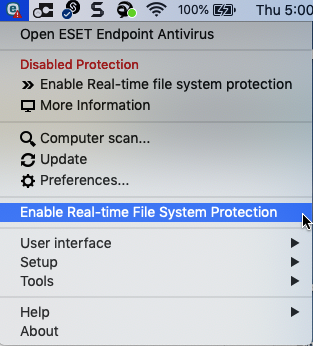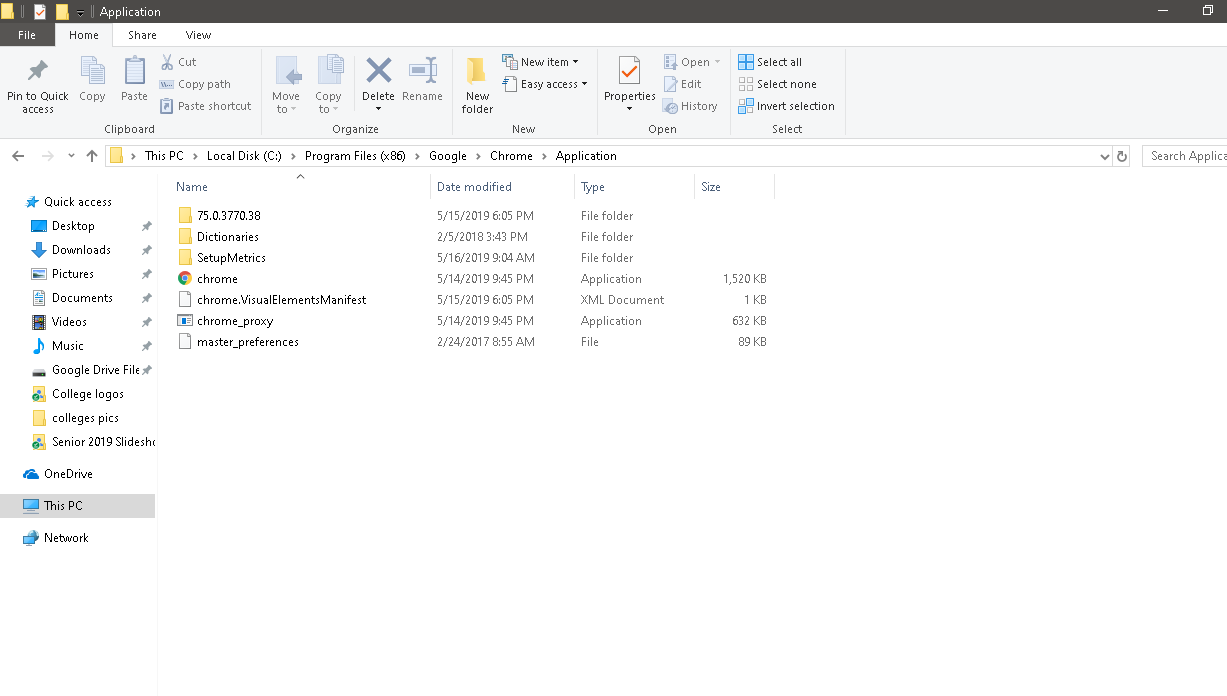-->
- Run Google Drive File Stream
- Drive File Stream Missing
- Google Drive Vs Drive File Stream
- Drive File Stream Application
- Update Drive File Stream
Important
Install Location (7 Folders, 189 Files, 247 MB) C: Program Files Google Drive File Stream. Launch command from the setup. START 'No Title' /b 'C: Program Files Google Drive File Stream 31.0.13.0 GoogleDriveFS.exe' –options=yAIA. Reg keys and drivers that get applied during setup. Google to release update for Drive File Stream service with Apple M1 support January 23, 2021 In November, Apple introduced the first Mac computers based on the Apple M1 ARM processor, and since then, developers have been actively updating their applications to provide native support for the new platform in their software. To install Google Drive File Stream on your work computer, we recommend that you use Software Center, which enables you to install software packages approved by the IT department without the need for administrator access to your computer. Just look for the Google Drive File Stream entry in the list of applications. Store, share, and access your files and folders from any mobile device, tablet, or computer—and your first 15GB of storage are free. Go to Google Drive Teams.
The information contained in this topic is meant to provide a preview of Microsoft Stream (built on SharePoint,) which will be launched later this year. Some features, screens, or functionality included in this topic may be modified, replaced, or removed without notice in the final release. Also, any release date mentioned is an estimate and may change.
A new vision for Microsoft Stream empowers users to create, share, discover, and manage video just as they would any other file.
With video that will be stored in Microsoft 365, the new version of Stream builds on the rich content management features of SharePoint and unlocks the intelligence of Microsoft Graph to enhance videos across Microsoft 365. The earlier version of Stream will now be known as Microsoft Stream (Classic) and Microsoft Stream (built on SharePoint) on first mention and Stream (on SharePoint) on subsequent mentions will be the new version.
Microsoft Stream—the intelligent video app in Microsoft 365—is being re-imagined and rebuilt to integrate seamlessly with applications across the suite, so you can create, share, discover, and manage video as easily as any Office document.
Video and audio files will be stored on the SharePoint files platform within Microsoft 365 like all other file types. Already today, SharePoint powers file experiences for Microsoft Teams, OneDrive, Yammer, and Outlook. This will provide the best of both worlds:
- intelligent video experiences powered by Stream across the suite, and
- management of video that leverages the power of SharePoint content services for permissions, sharing, compliance, governance, and customizable portal experiences.
Customers who want to create future-proof video experiences in Microsoft 365 can start building them today with SharePoint Online and Microsoft Graph File APIs.
Note
For customers using Stream (Classic), we will support your transition to Microsoft Stream over time, with a phased introduction of new features in Microsoft 365, migration tools, and guidance. The first key functionality we're enabling in 2020 are improvements to Teams Meeting Recordings, by having new meeting recordings saved to OneDrive and SharePoint, which enables key sharing and governance features.
Informational videos about Stream (on SharePoint)
Vision
Stream (on SharePoint) empowers every Microsoft 365 user to achieve more with fast, intelligent video.
To achieve that vision:
Stream (on SharePoint) expands its role to unlock the intelligence of Microsoft Graph and enhance videos across the Microsoft 365 services.
Stream web app follows the model of the Office web apps to easily work with video like any other document format.
Stream videos—like any files—can be uploaded and accessed from Teams, Yammer, SharePoint, and OneDrive.
Stream leverages the power of SharePoint content services to store and manage video using integrated Microsoft 365 compliance, governance, permissions, external sharing, go local storage, bring your own keys, and government environments.
Stream is flexible to allow customers to use a provided video portal template to easily modify and brand their own video portals or fully customize and integrate video experiences with their intranet and Microsoft 365.
Stream delivers new intelligent capabilities including, faster and more effective consumption of video content, quick location and extraction of relevant snippets of video, and easy end-user tools to capture screens and record video in Stream and across all Microsoft 365 apps.
Stream (Classic) vs Stream (on SharePoint)
The use cases for Stream (Classic) and Stream (on SharePoint) are the same however, the way in which those use cases are accomplished throughout Microsoft 365 is going to change slightly in Stream (on SharePoint).
Stream (Classic)
Stream (Classic) is loosely connected to other Microsoft 365 apps and services, but videos are stored separately. You upload your videos, manage them there, then link to those videos in other places and applications.
| Do more with files |
| File creation & get back to your files |
| Storage & files |
| How video & Stream (Classic) previously fit into Microsoft 365 |
Stream (on SharePoint)
In Stream (on SharePoint), you upload videos the same way you upload any other file, and they're automatically stored within the SharePoint files platform. Videos are played, enhanced, and edited by the newest version of the Stream web app and embeddable player.
In fact, videos across Microsoft 365 (in SharePoint, OneDrive, Yammer, and Teams) will be considered Stream videos, powered by the SharePoint files platform. And just like other Office file types, Stream videos can be shared with coherent permissions in all Microsoft 365 apps.
| Do more with files |
| File creation & get back to your files |
| Storage & files |
| How video and Microsoft Stream fits into Microsoft 365 |
Flexible video organization
There are many ways that people use and organize videos within their organization. Those common uses cases fall on a continuum from more locked down or constrained (on the left, below) to fully democratized (on the right, below) where everyone is encouraged to create videos to share.
| Common use #1: Employee personal or private | Common use #2: Organization-wide top down | Common use #3: Team collaboration | Common use #4: Organization-wide collaboration | |
|---|---|---|---|---|
| If you want ... | Simple video sharing and discovery of relevant team and organization videos that you can view | Anyone in the organization can view, but only a few can add videos | Only team members can view and add videos | Anyone in the organization can add videos that anyone can view |
| For example ... | • Single video editing and sharing with individuals or with a link • Getting back to your videos or those shared with you across Teams, Yammer, SharePoint, and OneDrive • Recording or uploading a new video | • Messages from the CEO or other leaders • Human Resources information • Onboarding training for new employees | • Any sort of team • Departments or divisions where everyone can contribute | • Single organization-wide video portal destination • Organization-wide video portal destination for specific topics or content |
| Use ... | Stream web app and OneDrive | Public SharePoint Communication Site or Public Yammer Community | Private Teams team | Option A: Rollup organization-wide video through a SharePoint communication site with highlighted content webparts scoped to videos across all sites Option B: Single destination for uploaded videos through a public SharePoint communication site that is open to all to upload |
| ◀◾◾◾◾ Constrained | ◾◾◾◾▶ Democratized |
If you want to help inform the roadmap, please:
add your ideas and vote for features on our Stream (on SharePoint) ideas forum: https://aka.ms/StreamIdeas/
connect with us directly by enrolling in our customer connection program: https://aka.ms/StreamConnect
Frequently asked questions
Will there be a migration from Stream (Classic) to Stream (on SharePoint)?
This new vision for Stream does mean that existing content will need to be migrated from Stream (Classic) to Stream (on SharePoint) to take full advantage of all that SharePoint and Microsoft 365 has to offer. Learn more about how this migration will work
Is there still a Stream application?

Yes, the newest version of the Stream web app will be tightly integrated with office.com. It will be just like when you select PowerPoint from the Microsoft 365 app launcher—you go to office.com and can access the PowerPoint files that are stored across Teams, SharePoint, OneDrive, and Yammer. You'll select Stream to access all your videos and create new ones.
Where will video files be stored?
Videos in Stream (on SharePoint) will be stored in the same place you store your Office files, in Teams, SharePoint, OneDrive, and Yammer. Stream will enhance those videos—powering the playback and adding intelligent video experiences on top.
How will storage quota work?

Videos in Stream (on SharePoint) will consume the existing file storage quota from OneDrive and SharePoint, which means there are lots of storage management tools and the ability to monitor and clean up content, as needed.
Also, Teams meeting recordings make up the majority of many customers' current Stream storage, so the fact that this content is shifting heavily to OneDrive means most meetings won't consume your SharePoint storage quota. Also, if you have the right Microsoft 365 security and compliance licenses, you can add automatic retention labels and policies via the Microsoft 365 compliance center to target and clean up meeting recordings after a certain number of days.
Run Google Drive File Stream
We'll be adding a new feature for all expired license types that deletes meeting recordings automatically after a certain number of days, so IT admins who want to change that time limit can do so, and the user will be able to flag specific recordings that need to be kept longer.
How is video playback different in the Stream (on SharePoint) vs Stream (Classic)?
Drive File Stream Missing
Stream (Classic) pre-encodes and encrypts all video uploads to multiple bitrate and resolutions for adaptive bitrate streaming through CDN.
Today, OneDrive and SharePoint video playback use different playback technology depending on the video bitrate.
Smaller videos (<3 Mbps bitrate or video itself is <5 Mb)—Use progressive playback, so the video needs to be created with a video codec supported by the browser and the device
Medium bitrate videos (3-50 Mbps) and Microsoft Teams meeting recordings—Use 'just in time' encoding to do adaptive bitrate streaming on the fly when a user plays the video and caches AES-128 encrypted parts of the video on the Azure Front Door CDN as many people play the video from the same geographic region
Large bitrate videos (50+ Mbps)—Cannot be played in the service and can be only downloaded for local playback
Over time, Stream (on SharePoint) will improve the above playback technology that exists in OneDrive and SharePoint to ensure a high-quality and performant playback experience that matches Stream (Classic), where you don't need to worry about bitrates or codecs for your videos. You just upload your video and Stream ensures your viewers can play it back at scale.
As a Stream admin, can I still act on all Stream (Classic) videos in Stream (on SharePoint)?

Yes, the newest version of the Stream web app will be tightly integrated with office.com. It will be just like when you select PowerPoint from the Microsoft 365 app launcher—you go to office.com and can access the PowerPoint files that are stored across Teams, SharePoint, OneDrive, and Yammer. You'll select Stream to access all your videos and create new ones.
Where will video files be stored?
Videos in Stream (on SharePoint) will be stored in the same place you store your Office files, in Teams, SharePoint, OneDrive, and Yammer. Stream will enhance those videos—powering the playback and adding intelligent video experiences on top.
How will storage quota work?
Videos in Stream (on SharePoint) will consume the existing file storage quota from OneDrive and SharePoint, which means there are lots of storage management tools and the ability to monitor and clean up content, as needed.
Also, Teams meeting recordings make up the majority of many customers' current Stream storage, so the fact that this content is shifting heavily to OneDrive means most meetings won't consume your SharePoint storage quota. Also, if you have the right Microsoft 365 security and compliance licenses, you can add automatic retention labels and policies via the Microsoft 365 compliance center to target and clean up meeting recordings after a certain number of days.
Run Google Drive File Stream
We'll be adding a new feature for all expired license types that deletes meeting recordings automatically after a certain number of days, so IT admins who want to change that time limit can do so, and the user will be able to flag specific recordings that need to be kept longer.
How is video playback different in the Stream (on SharePoint) vs Stream (Classic)?
Drive File Stream Missing
Stream (Classic) pre-encodes and encrypts all video uploads to multiple bitrate and resolutions for adaptive bitrate streaming through CDN.
Today, OneDrive and SharePoint video playback use different playback technology depending on the video bitrate.
Smaller videos (<3 Mbps bitrate or video itself is <5 Mb)—Use progressive playback, so the video needs to be created with a video codec supported by the browser and the device
Medium bitrate videos (3-50 Mbps) and Microsoft Teams meeting recordings—Use 'just in time' encoding to do adaptive bitrate streaming on the fly when a user plays the video and caches AES-128 encrypted parts of the video on the Azure Front Door CDN as many people play the video from the same geographic region
Large bitrate videos (50+ Mbps)—Cannot be played in the service and can be only downloaded for local playback
Over time, Stream (on SharePoint) will improve the above playback technology that exists in OneDrive and SharePoint to ensure a high-quality and performant playback experience that matches Stream (Classic), where you don't need to worry about bitrates or codecs for your videos. You just upload your video and Stream ensures your viewers can play it back at scale.
As a Stream admin, can I still act on all Stream (Classic) videos in Stream (on SharePoint)?
Google Drive Vs Drive File Stream
The Stream admin role only applies to Stream (Classic).
Drive File Stream Application
Currently, SharePoint admins can act on any file stored in SharePoint. This ability will remain true for any videos, too. If an admin finds a set of videos from links sent to them or through an audit or eDiscovery search, a SharePoint admin can then add themselves as a site admin for the user's OneDrive or add themselves as a site admin of a shared site, then they can act on all files within it.
